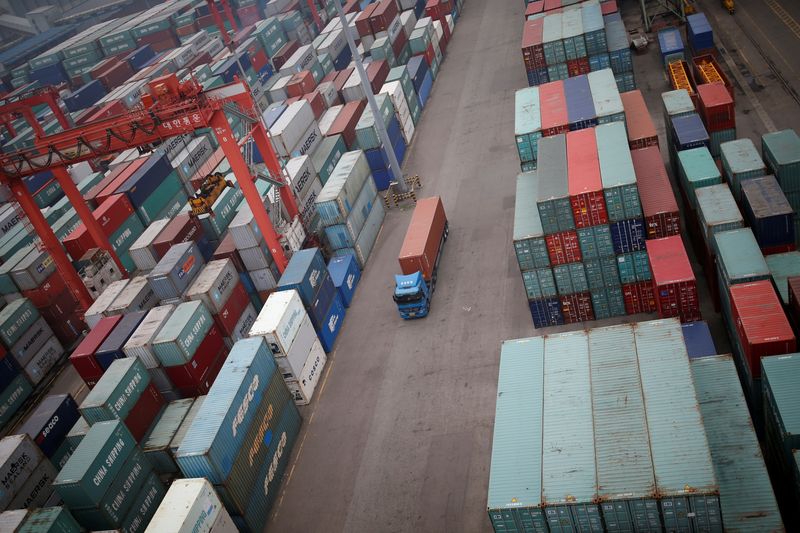Select Language

By Hernan Nessi and Jorgelina do Rosario
BUENOS AIRES/LONDON (Reuters) -Argentina on Monday set new weaker trade-related exchange rates while keeping the official peso rate stable, in a push to meet expectations in its $44 billion agreement with the International Monetary Fund while avoiding a politically costly devaluation.
Corn exporters will be able to sell their goods abroad at 340 pesos per U.S. dollar, according to a government decree, a temporary rate to bolster exports until Aug. 31. That is about 27% weaker than the current rate of 268 pesos per dollar, which remained unchanged.
The government will also introduce a 7.5% tax on some goods imports and a 25% levy on imports of most services, with new FX rates at around 288 and 335 pesos per dollar, respectively, according to a government official.
The move comes as the country faces delayed talks with the IMF on the fifth review of a $44 billion program, which was scheduled for June.
The measure is a "half-way point between the devaluation requested by the IMF and the political order not to devalue during an election year," said Roberto Geretto, an economist at Fundcorp.
Argentina's government is grappling with an annual inflation rate of over 100% which a wider devaluation would exacerbate.
"The fiscal devaluation improves Treasury revenues and helps save reserves," Geretto added, but there are still "points to resolve" in negotiations. Both parties have said a deal is close, but an agreement is not finalized yet.
The country's overseas bonds climbed as much as 1.4 cents on the dollar, according to MarketAxess data. The 2035 dollar note is trading at 31.8 cents, its highest level since January 2022, although still at deeply distressed levels.
An IMF spokesperson said the measures announced by the Argentine authorities are "positive to strengthen reserves and consolidate the path of fiscal order, fundamental variables to strengthen economic stability."
'BIG PACKAGE OF DISBURSEMENTS'
Argentina faces maturities with the IMF worth some $3.4 billion between July and August, at a time when the central bank's net reserves are about $6.5 billion in the red.
Buenos Aires is hoping to alter the economic goals it had agreed with the global lender and bring forward some IMF disbursements scheduled for this year as it battles a severe financial crisis which a lack of reserves could exacerbate.
An economy ministry source told Reuters the disbursement program for the second half of 2023 has been agreed and the staff level agreement could be sealed on Wednesday or Thursday.
Economy Minister Sergio Massa, who is running for president ahead of an August primary vote, said on Sunday in an interview with a local TV network that there is a "big package of disbursements" in August and November under the IMF program, without providing any further details.
Under the current program, the country is expected to get $4 billion in July, more than $3.3 billion in September and another $3.3 billion in December. These disbursements are set to mainly repay a failed 2018 bailout.
Argentina, which is also struggling with a significant fiscal deficit, has suffered a considerable hit to its foreign currency income due to a severe drought which crimped farm output, its principal source of exports.

LONDON (Reuters) - British Prime Minister Rishi Sunak will commit to a promise to build 1 million homes by the next national election, tackling a lack of housing stock that has alienated some younger voters who are often forced to pay high rents and are unable to buy.
Before an election expected next year, Sunak's governing Conservatives have witnessed a collapse of support among younger voters, who are frustrated at being priced out of owning their own homes and are struggling with high childcare costs.
Housing has long been a contentious area for the Conservatives, who are divided between some lawmakers in rural areas who do not want to see an increase in building and want to protect greenbelt protected land, and between those in more urban regions, who want to see more homes built quickly.
Housing minister Michael Gove will set out further measures on Monday to unblock the planning system and build homes in the "right places" where there is local consent to reach the 1 million target that was set out at the 2019 election.
Sunak said his government would concentrate on building in inner-city areas where demand was highest, including a new urban quarter in Cambridge to boost its role as a science hub.
"Today I can confirm that we will meet our manifesto commitment to build 1 million homes over this parliament. That's a beautiful new home for a million individual families in every corner of our country," Sunak said, using a term that refers to the time between the 2019 election and the next vote.
"We won't do that by concreting over the countryside - our plan is to build the right homes where there is the most need and where there is local support, in the heart of Britain’s great cities," he said in a statement.
The housing plan is the latest attempt by Sunak to reduce the opposition Labour Party's large poll lead after an unexpected victory in a so-called by-election just outside central London on Friday offered him some breathing space.
In June, British house building at the sharpest pace in more than 14 years apart from two months early in the COVID-19 pandemic, as higher borrowing costs dampened demand and weighed on the broader construction sector, a survey said this month.
Earlier this month, a parliamentary committee said the government was on track to deliver 1 million new homes, but was not forecast to deliver another promise to build 300,000 net new homes per year by the mid-2020s, largely because of uncertainty over planning policy reform.

By Naomi Rovnick and Stefano Rebaudo
LONDON (Reuters) - The European Central Bank looks set to pull the rate-hike trigger on Thursday, but what it will do after July is less certain and financial markets are craving some guidance.
Euro zone interest rates have risen 400 basis points in the last year to 3.5%, their highest in 22 years, and are now close to peaking as headline inflation cools and the economy weakens.
"The difference (from past meetings) is that until now they've given at least quite precise guidance vis-a-vis the next meeting," said Barclays (LON:BARC) head of European economics research Silvia Ardagna. "And we expect that to become more loose."
Here are five key questions for markets.
1/ How much will the ECB hike rates?
A quarter percentage point increase to 3.75% is priced in by markets and forecast by economists.
Headline inflation is cooling but remains high enough to justify a modest increase. The ECB has flagged a July move.
"The ECB will hike again and anything else would be a major surprise," said RBC Capital Markets global macro strategist Peter Schaffrik.
2/ What signals is the ECB likely to send about future policy?
Market consensus for one more hike after July is no longer rock solid after some ECB hawks suggested that a September rise is not certain, so the ECB could turn more cautious in its signalling, while confirming it will be data dependent.
"(ECB President Christine) Lagarde will stress uncertainty and conditionality (when and if she mentions further tightening)," said Massimiliano Maxia, senior fixed income specialist at Allianz (ETR:ALVG) Global Investors.
Some analysts expect the ECB to pause in September, when updated staff forecasts will give it an opportunity to signal that inflation is set to reach its 2% target.
They added that they wouldn't be surprised if the ECB paused then and hiked later if needed, as the U.S. Federal Reserve has done. Money markets price in one more hike after July, suggesting rates will peak at around 4%.
3/ When does the ECB expect core inflation to fall?
While headline inflation fell for a third straight month in June, so-called core prices, such as those for services, have risen stubbornly and are not expected to relent soon.
Core inflation, seen as a better gauge of the underlying trend, only edged lower to 6.8% from 6.9% - far from the sustained drop rate-setters want to see.
ECB chief Lagarde will likely be pressed on this question but may not give too much away before September's fresh economic projections.
"Underlying inflation will be very, very slow to come down so this is a worry for the ECB," said UBS chief European economist Reinhard Cluse, noting a tight labour market and wage pressures.
4/ What does a weakening economy mean for policy?
Well, rate-setters have reiterated that the main focus remains inflation, even if monetary tightening hurts the economy.
"I think (the weakening of the economy) will have minimal impact on monetary policy," said Ruben Segura-Cayuela, Europe economist at BofA. "What matters for the September meeting will be core inflation."
Still, slowing growth could strengthen the hands of doves. Euro zone business activity stalled in June as a manufacturing recession deepened and a previously resilient services sector barely grew.
BofA reckons the ECB's forecasts are too optimistic; Barclays expects a stagnation for several quarters starting from the second half of 2023.
5/ What impact is tighter policy having on financing conditions?
Bank lending data suggests the steepest surge in borrowing costs in the ECB's history has started to take a toll on credit conditions and latest numbers on July 25 are in focus.
The ECB's chief economist Philip Lane says loan volumes have weakened sharply and that this may generate a "substantial" decline in economic output.
This dovish message, if reinforced by latest bank lending data, may fuel speculation that rates are close to peaking.
"The peak impact of tightening financing conditions is going to be at the end of this year and the first half of 2024. So a lot of the effect still has to come," said BofA's Segura-Cayuela.

By Lewis Jackson
SYDNEY (Reuters) - Australia Treasurer Jim Chalmers said on Monday the country's first budget surplus in 15 years would be even larger than first forecast.
Chalmers said the budget surplus for the financial year just past was likely to be a little over A$20 billion dollars, well up from the A$4.2 billion projected in the May budget as first flagged last month.
"The current expectation of the officials is that the surplus for 2022-2023 will be around twenty billion dollars, or more likely just north of that figure," Chalmers told a news conference in Canberra.
The final figures, due within weeks, mark an astonishing turnaround from the A$37 billion deficit forecast as recently as October thanks to higher tax revenue from low unemployment, rising wages and record commodity exports.
The surplus will be short-lived, with deficits forecast this financial year and next due to rising interest bills and spending on disability care, health and defence.
Chalmers reiterated forecasts for economic growth to slow this year. Australia is closely monitoring weaker economic data coming out of China, its largest trading partner, he said, but has not downgraded its own growth forecast.
"We need to be realistic about the consequences and the implications of the rate rises on our economic and this global uncertainty which we all confront. China is part of that story," he said.
Chalmers also announced Chris Barrett would head Australia's Productivity Commission, an independent research and advisory body. Barrett was an ambassador to the OECD, and, like Chalmers, served as chief of staff to former Treasurer Wayne Swan.

BUENOS AIRES (Reuters) - The International Monetary Fund (IMF) should in the coming days finalize the basis for a staff level agreement with Argentina over a review of the country's $44 billion loan with the IMF, the Washington-based fund said on Sunday.
"The teams of the Economy Ministry and Central Bank of Argentina and the IMF staff have finished the core aspects of the technical work of the next review," the IMF said on Twitter.
"The central objectives and parameters that will be the basis for a "staff level agreement" have been agreed, which is expected to be finalized in the next few days before moving towards the review of the Argentina program," it added.
Argentina faces maturities with the IMF worth some $3.4 billion between July 31 and Aug. 1, at a time when the central bank's net reserves are about $6.5 billion in the red.
The South American country is hoping to alter the economic goals it had agreed with the fund and bring forward some IMF disbursements scheduled for this year as it battles a severe financial crisis which a lack of reserves could exacerbate.
An Economy Ministry source told Reuters the disbursement program for the second half of 2023 has already closed and that the staff level accord could be sealed on Wednesday or Thursday.
Argentina, which is also struggling with high inflation and a significant fiscal deficit, has suffered a considerable hit to its foreign currency income due to a severe drought which crimped its principal source of exports, agriculture.
The IMF said the agreement seeks to consolidate "fiscal order and strengthen reserves," acknowledging the impact of the drought, as well as the damage to exports and tax revenues.

Investing.com -- The week will be dominated by central bank meetings, with the Federal Reserve and the European Central Bank both poised to deliver rate hikes, while the Bank of Japan stands pat. A rally in U.S. equities markets faces an inflection point and oil looks set for more gains amid concerns over the supply outlook.
Fed decision day
With the Fed all but certain to raise interest rates again at the conclusion of its latest policy setting meeting on Wednesday, investors are focusing their attention on whether this is likely to be the final hike of its tightening cycle.
The Fed paused rate hikes in June after increasing its policy rate by 500 basis points since March 2022, when it kicked off its fastest monetary policy tightening cycle in more than 40 years in a bid to combat spiraling inflation.
Investors have mixed views on the central bank's longer-term monetary policy outlook.
Analysts at Goldman Sachs said Friday that while they expect this hike to be “the last” of the long-running tightening cycle they believe the Fed will ultimately choose to "remain more hawkish than market pricing."
"The key question is how strongly [Fed] Chair [Jerome] Powell will nod toward the 'careful pace' of tightening he advocated in June, which we and others have taken to imply an every-other-meeting approach."
ECB meeting
The ECB is widely expected to deliver another 25-basis point rate hike at its upcoming meeting on Thursday, so all eyes are on the central bank’s plans for September, with markets divided on whether there will be another hike or a pause.
Inflation in the eurozone has cooled since hitting a peak of 10.6% in December but still remains well above the ECB’s 2% target. The ECB has said inflation was "projected to remain too high for too long" and it still had "more ground to cover".
After eight consecutive rate rises since July 2022 for a total of 400 basis points, investors and analysts are now hotly debating how many more hikes are needed and how long rates will have to stay high to bring inflation back to target.
ECB President Christine Lagarde is likely to reiterate that future decisions will be based on incoming economic data.
BOJ decision
Friday’s monetary policy decision by the BoJ will be keenly anticipated amid ongoing speculation that policymakers could adjust their ultra-loose monetary stance amid elevated price pressures.
Data on Friday showed that Japan's core inflation stayed above the central bank's 2% target in June for the 15th straight month but an index stripping away the effect of energy costs slowed, indicating price pressures may have peaked.
While the data heightens the chance the BoJ will upgrade this year's inflation forecast, it may take pressure off the central bank to soon begin phasing out its massive monetary stimulus, analysts say.
"All expectations are for them to keep yield curve control as is and no changes to rates, but maybe a little upgrade on their inflation outlook," Edward Moya, senior market analyst at OANDA in New York told Reuters.
However, "the chances that we could get a surprise should remain on the table," Moya added. "The BOJ is potentially going to be a major market-moving event because time’s running out on the BOJ to really set up a policy shift.”
Stock market faces test
A rally in U.S. equities markets faces a major test this week with the Fed expected to deliver what may be the final rate hike of its most aggressive monetary policy tightening cycle in decades.
At the start of the year, many investors expected higher interest rates to bring on a recession that would further hurt stocks after 2022's sharp decline. Instead, the U.S. economy is proving resilient even as the Fed has made progress in its inflation fight and investors are embracing the idea of a ‘soft landing’.
The belief that the Fed is nearing the end of its tightening cycle has boosted stocks in recent weeks.
Aside from the Fed, investors will also be focusing on earnings from some of the massive tech and growth stocks that have led markets higher this year. Among them are Microsoft (NASDAQ:MSFT) and Alphabet (NASDAQ:GOOGL), which report on Tuesday after the market closes.
Both tech behemoths are up sharply year-to-date, driven by optimism that demand for artificial intelligence will bolster future growth.
Oil prices
Oil prices rose nearly 2% on Friday to notch up a fourth consecutive weekly gain, buoyed by growing evidence of supply shortages in the coming months and rising tensions between Russia and Ukraine that could further hit supplies.
Brent crude futures rose $1.43, or 1.8%, to settle at $81.07 a barrel, with a weekly gain of about 1.2%. U.S. West Texas Intermediate crude ended $1.42, or 1.9%, higher at $77.07 a barrel, its highest since April 25. WTI gained nearly 2% in the week.
"The oil market is starting to slowly price in a looming supply crunch," Price Futures Group analyst Phil Flynn told Reuters.
"Global supplies are starting to tighten and that could accelerate dramatically in the coming weeks. Increased war risk could also impact prices," Flynn said.
--Reuters contributed to this report

By Leika Kihara and Takahiko Wada
TOKYO (Reuters) -Japan's core inflation stayed above the central bank's 2% target in June for the 15th straight month but an index stripping away the effect of energy costs slowed, data showed, suggesting the prolonged commodity-driven price pressures may have peaked.
Yet, with services price growth also slowing last month, policymakers will feel that wage pressures have yet to build up enough to warrant an imminent tweak to the ultra-loose monetary stance.
While the data heightens the chance the Bank of Japan (BOJ) will upgrade this year's inflation forecast next week, it may take pressure off the central bank to soon begin phasing out its massive monetary stimulus, analysts say.
"Cost-push inflation is finally beginning to peak out. We'll likely see inflation slow in coming months, which would allow the BOJ to keep policy steady for the time being," said Toru Suehiro, chief economist at Daiwa Securities.
"While services prices may rise next year, those for goods will stay weak. Inflation could hover around 1% next year."
The nationwide core consumer price index (CPI), which excludes fresh food costs, rose 3.3% in June from a year earlier, matching a median market forecast and accelerating from a 3.2% gain in May, data showed on Friday.
A hike in utility bills added to a steady increase in food and daily necessity prices, increasing the burden for households.
But an index stripping away both fresh food and fuel costs, which is closely watched by the BOJ as a better gauge of trend inflation, rose 4.2% in June from a year earlier, slower than a 4.3% gain in May.
It was the first slowdown since January 2022 in a sign the rapid pace of increase seen in the past few months, driven by a flurry of price hikes by companies, was moderating.
Services prices, closely watched by policymakers on whether inflation is becoming driven more by higher labour costs, rose 1.6% in June from a year earlier after a 1.7% gain in May.
The data comes ahead of the BOJ's closely-watched policy meeting on July 27-28, when the board will release fresh quarterly projections and discuss how much progress Japan is making towards sustainably achieving its 2% inflation target.
Core inflation in Japan's capital, set for release hours before the BOJ's policy announcement on July 28, also likely slowed sharply in July, according to a Reuters poll.
With inflation having exceeded the BOJ's target for more than a year, markets are simmering with speculation the BOJ could soon phase out its controversial yield curve control (YCC) policy as early as next week.
BOJ Governor Kazuo Ueda has stressed the need to keep policy ultra-loose until the recent cost-push inflation shifts into one driven by robust domestic demand and higher wage growth.
The key would be whether companies will continue offering higher pay next year, similar to this year, and start translating the rise in labour costs to services prices.
"If more firms hike wages and pass on the cost, services prices could overshoot," said Yoshiki Shinke, chief economist at Dai-ichi Life Research Institute.
"Inflation excluding food and energy will likely moderate ahead, but the pace of slowdown could be gradual."
Under YCC, the BOJ guides short-term interest rates at -0.1% and buys huge amounts of government bonds to cap the 10-year bond yield around 0% as part of efforts to fire up inflation to its 2% target.

SEOUL (Reuters) - South Korea's exports are expected to recover going forward, but at a sluggish pace compared with the past due to a narrower gap in competitiveness against China, the central bank said in a report published on Friday.
"Even if the sluggishness of the information technology (IT) industry cycle eases from the second half of this year, exports are not expected to rebound by as much as in the past due to structural changes in the Chinese economy," the Bank of Korea (BOK) said.
The BOK said that recent weakness in China-bound exports was 35% due to structural factors such as higher competitiveness of Chinese companies, while 65% resulted from a cyclical factor of weak demand.
The estimates were based on data comparison before and after China scrapped its stringent COVID-19 lockdown measures late last year, according to the report.
Separate data showed on Friday South Korea's exports for the first 20 days of July dropped 15% over a year, after falling 6% for the whole of June.
The data suggests that exports are due to extend their downturn this month to a tenth consecutive month, which has been mostly driven by China-bound shipments of semiconductors, and it may take some time for exports to fully get on a recovery path.
Amid divergence between weak semiconductor exports to China and strong automobile sales to the U.S. and the European Union, Asia's fourth-largest economy posted a surplus of $56.38 billion in trade of goods with the U.S. last year, far larger than the $15.06 billion with China, which had been the biggest market for years.
Exports of automobiles, mostly shipped to the U.S. and the European Union, will continue to grow gradually going forward, the BOK said in the report.

By Anant Chandak
BENGALURU (Reuters) - South Korea's economic growth likely slowed a bit last quarter as languishing exports and high interest rates hurt private consumption that accounts for about half of the economy, a Reuters poll of economists found.
While exports from Asia's fourth-largest economy declined in June, imports also fell, indicating a lack of vitality in domestic and foreign demand, especially from China, the country's largest trade partner.
On a year-on-year basis, gross domestic product (GDP) was expected to have expanded 0.8% in the April-June period, according to the median forecast of 22 economists, slightly slower compared to a revised 0.9% growth in January-March.
However, on a quarterly basis, the export-led economy grew a seasonally adjusted 0.5%, a tad higher than 0.3% growth in the preceding quarter, underscoring a lacklustre recovery after it narrowly avoided a technical recession in Q1.
"GDP growth...is expected to be at a similar pace to the first quarter, due to sluggish exports and manufacturing sector, weak investment as well as smaller government spending," said Park Sang-hyun, economist at HI Investment and Securities.
"Economic growth is expected to rebound in the second half of this year...but it will depend on the pace of economic recovery in China."
Initial hopes for an economic boom in China, buoyed by the ending of COVID pandemic-led lockdowns, have been dashed as the world's second-biggest economy is now projected to grow just 5.5% this year and 4.8% next. [ECILT/CN]
Underwhelming growth figures have sent shockwaves through the global economy, impacting not only South Korea but also other Asian economies that heavily rely on Chinese demand, raising concerns about the broader economic outlook.
South Korea's economic growth was forecast to average 1.2% this year, a sharp fall from 2.6% seen last year, a separate Reuters poll showed.
"The economy is set to struggle...as domestic demand remains suppressed by tight monetary policy while exports are likely to weaken as demand from advanced economies weakens and the boost from automotive production fades," wrote Shivaan Tandon, emerging Asia economist at Capital Economics.

By Olena Harmash
KYIV (Reuters) -Ukraine's central bank said it will nationalise Russian-owned Sense Bank, one of the country's top commercial banks, and put it under temporary administration on Friday.
The National Bank of Ukraine (NBU) said in a statement on Thursday it decided to "withdraw from the market the systemically important" bank and submitted a proposal to the government on the state's participation in the process.
The "safe" transfer will not be noticeable to clients, NBU Governor Andriy Pyshnyi told a media briefing.
Previously known as Alfa-Bank Ukraine, Sense Bank is Ukraine's 10th largest in terms of assets and is on the list of systemically important banks, central bank data showed.
As part of its economic response to Moscow's large-scale invasion on Feb. 24, 2022, Kyiv has imposed sanctions on Russia and opened court cases to confiscate assets held by the Russian state in Ukraine and businessmen close to the Kremlin.
In June, President Volodymyr Zelenskiy signed into law the legislation allowing the government to nationalize banks from owners that came under sanctions due to Russia's invasion.
In his nightly video address, Zelenskiy took note of the central bank's move, without identifying Sense Bank by name.
"It is now only right that the cabinet of ministers immediately considers the relevant proposals of the central bank and supports them in relation to this financial institution," Zelenskiy said.
"In the interests of investors, for the sake of financial stability and fundamental justice."
'SIGNIFICANT RISK'
The central bank said the connections of Sense Bank's owners with Russia "pose a significant reputational risk and have a significant negative impact on the bank's activities."
"The regulatory capital of Sense Bank fell by 50% in the period from March 1, 2022, to July 1, 2023, while at the same time, it grew by about 29% at other systemically important banks," Pyshnyi said.
Ukrainian-born Russian-Israeli businessman Mikhail Fridman has a 32.86% stake in ABH Holdings S.A., the majority owner of Sense Bank, while Russian magnate Petr Aven holds 12.4%, the bank said on its website. Fridman and Aven could not be immediately reached for comment.
Sense Bank, with 3 million depositors, posted losses of 7 billion hryvnias ($189.75 million) in 2022, the central bank said.
The Ukrainian financial sector and its banking system have proved remarkably resilient during nearly 17 months of the war under the central bank and government's policies and strong financial support from Kyiv's Western partners.
Central bank officials said they discussed their plans to nationalise the bank with the International Monetary Fund, the country's key lender.
The officials said the government's decision was expected on Friday and all steps on the bank's nationalisation should be completed over the weekend.
Fridman and Aven are long-term partners in oil, banking and retail businesses and they face Western sanctions over their alleged ties to the Kremlin following Russia's invasion of Ukraine. Fridman, who was born in western Ukraine during the Soviet-era times, cast the war in Ukraine as a tragedy.
($1 = 36.8910 hryvnias)

